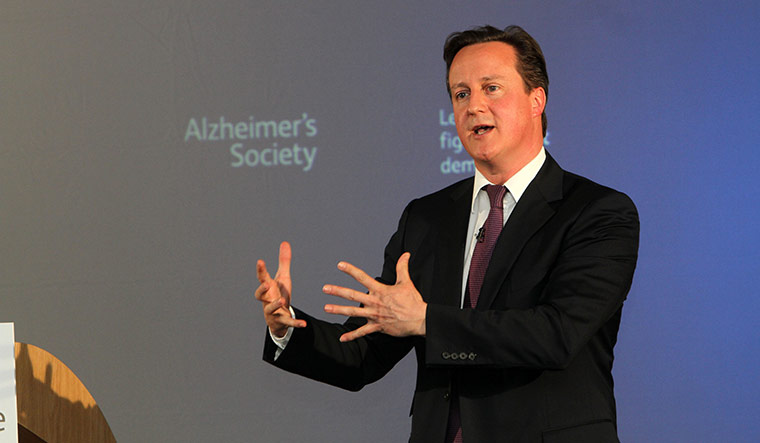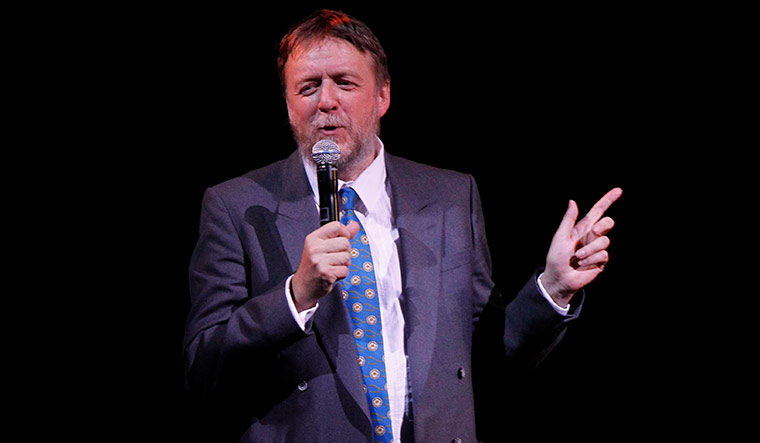Almost four decades after a desperate woman sent John Hardy a desperate letter, and a decade after that the woman began, as she always feared, to lose her mind, came a vindication of sorts.
It arrived in a fact sheet for doctors produced by the US Food and Drug Administration, giving information on the country’s newest drug. “Aduhelm,” it began, “is an amyloid beta-directed antibody indicated for the treatment of Alzheimer’s disease.”
With that mundane opening sentence an experimental drug became a clinical one. The US regulators had, at last, approved a drug to treat Alzheimer’s.
If you accept that regulator’s assessment, and we will come to that, it meant more than merely that Hardy was right—that the hypothesis he pioneered towards the start of his career has been proved towards its end. It meant the billions of pounds thrown at his idea had not been wasted after all.
It was, said Hilary Evans, chief executive of Alzheimer’s Research UK, “a pivotal moment”. Bart De Strooper, director of the UK Dementia Research Institute, called it a “major milestone”.
Yet, Hardy, a UCL (University College, London) professor, who works with De Strooper, is not quite as jubilant as you would think about a development that, without hyperbole, brings him significantly closer to a Nobel. “I wouldn’t put it as strong as vindicated,” he said, on a warm summer’s evening in his garden in Leytonstone, east London. “I guess… I don’t feel as depressed as I had been.”
Aduhelm, also known as aducanumab, is the apotheosis of Hardy’s work. For aducanumab to work it means, as he predicted, that Alzheimer’s is caused by a toxic protein called amyloid.
And for the first time it means there is a treatment to clear that protein: to deal with the causes, rather than the symptoms, of an insidious disease predicted to afflict millions more.
The drug’s existence is so much more than many dreamt possible just two years ago. It is also so much less than Hardy hoped for.
“We had this magic pill dream. One ring to rule them all,” he said.
“And that’s clearly not the case.”
The story of amyloid and aducanumab is a story of science itself. It is a story of dogged research; occasional inspiration; years of thankless, potentially futile graft; hubris and disappointment; feuds; triumph and caveats. Lots of caveats.
It could begin in many places. It could begin with Roger Nitsch, the University of Zurich scientist, who in the early noughties identified a natural antibody that seemed to keep amyloid at bay. It began in 1905 with Alois Alzheimer, a German psychiatrist, whose patient lived in Frankfurt’s Irrenschloss, the “Castle of the Insane”. She was confused. She forgot her name. She forgot what to call the food on her plate. “I am lost,” she said. When she died, Alzheimer cut her open and found clumped-up plaques of protein in her brain.
But there is a date in between, in the mid-eighties, when that letter landed in Hardy’s academic pigeonhole, that is as good a place to start as any.
Genetics was a new field then and Hardy had been inspired by research into Huntington’s disease that had found a single gene was the cause. He put out an advert in an Alzheimer’s newsletter for people who thought the same was true in their family history of Alzheimer’s.
Carol Jennings, from Nottingham, replied. “Dear sir,” she began in careful handwriting. “I was very interested to read of your research in the Alzheimer’s Disease Society News and think my family could be of use.”
Her 63-year-old father had Alzheimer’s, she said, “as does his sister Audrey. His brother Arthur also may have the disease.”
Hardy remembers reading it. “She said, ‘My doctor keeps telling me it doesn’t run in the family, but here’s my family tree, and it clearly does.’” Throughout her family were people who developed Alzheimer’s and did so in their fifties, and she wanted answers. “She’s a very determined woman, a remarkable woman.”
This is the letter that launched a thousand studies, the letter that, in a roundabout way, led to investments worth billions. This letter is the reason not only that I am sitting in Hardy’s garden, but the reason that he has this garden at all. It is the letter that means, perhaps, we have the first glimmer of a hint of a glint that we can cure Alzheimer’s.
Other families with genetic Alzheimer’s would be found. Other researchers, Hardy is keen to emphasise, would follow the clues down the same path he took. But he was there at the front, from the start.
Most people don’t have genetic Alzheimer’s, not in the sense that a single gene causes the condition. But in those people like the Jennings family, he thought, might lie a clue. Their mutation could be a pointer to the disease in the population at large.
These days, identifying the key gene from the family members might take a postdoctoral student a month. Back then it was very different. Without any modern tools, “It was chaotic really. There were a series of genetic markers scattered around,” Hardy said. It took six of them five years. “So, 30 person years of work.”
They presented the results to the family, confirming what they suspected: that their situation was not normal. Each family member had a 50 per cent chance of getting the disease while young. They were, oddly, pleased. “They were just delighted that their fears, which had been dismissed, were proved.”
Then began the job of working out what it meant.
A gene is a code for making a protein. And protein is a building block for making a body. If you find out what a faulty gene is, you can find out what it codes for. If you find out what it codes for, you can identify the building block that has gone wrong.
In the case of the Jennings family that building block was called amyloid precursor protein (APP). As its name suggests, this protein is part of a pathway that leads to the amyloid protein.
In those genetically predisposed to early onset Alzheimer’s, they make too much amyloid, or it is not as soluble as it should be. From here, to Hardy, the chain of events seemed obvious.
Too much amyloid is deposited, it causes tangles of another toxic protein called tau, which causes neuronal death. In those with genetic Alzheimer’s this happens early, because they make too much APP.
In those with normal Alzheimer’s this happens a bit later, because their brains are too slow at clearing amyloid. Either way, amyloid is the trigger.
In 1991, Hardy and his colleague David Allsop published what became known as the amyloid hypothesis. It would, they concluded, “facilitate rational design of drugs to intervene in this process”. A cure was just around the corner, and Alzheimer’s was a hot research topic.
But when a topic is hot, it attracts the most ambitious researchers. And ambitious researchers have a tendency not to agree with each other.
“The first thing we did was organise a meeting in Oxford and we invited all the other people who were starting out,” said Hardy. They all had their own ideas and not all saw the amyloid hypothesis as so obvious.
Could it be triggered, in fact, by infection? Was tau the crucial target? Many old people die with lots of amyloid but no dementia—might it be irrelevant? Could it even be nature’s way of protecting the brain? Could it be that identifying it as the cause of dementia was like identifying a scab as the cause of a stab wound?
It didn’t help that our knowledge of the brain was—is—so poor. “Obviously [APP] has a function. We don’t know what that function is,” said Hardy. “That’s embarrassing.”
So the field fractured. “There was an editorial in Nature Genetics in 1997 saying that Alzheimer’s genetics was the most fractious field—even more fractious than Aids research, which was the standard applied.”
There was one researcher, Mark Smith, from Case Western Reserve University, who would regularly challenge Hardy at conferences. “He was always saying amyloid was rubbish. We used to get on stage to debate each other and then go to the bar.”
It was infuriating. Looking back, he thinks, “The disagreement was good because we did different experiments, and although we were denigrating each other’s work, that’s how we led to progress.”
Progress, though, was slow. There were mutterings that amyloid was attracting all the funding but not providing the breakthroughs. In 2009, Hardy wrote an article in the Journal of Neurochemistry that addressed those who were claiming that his idea had corralled all the money to the detriment of the field.
“Whether this chorus is like the dawn chorus, heralding a bright new era of Alzheimer’s research, or a malcontent’s chorus, merely whingeing that their grants go unfunded, is open to debate.” This is not the kind of language regular readers of the Journal of Neurochemistry would have expected.
Still, consensus coalesced around amyloid. So much so that in 2015 Hardy received the $3 million Breakthrough Prize in life sciences, the largest cash prize in science.
As luck would have it, he was moving house at the time. “You’re seeing the prize,” he said, with an expansive sweep around his garden.
It’s a big house by London standards, though not absurdly so. There is a very big hot tub. There is a small mews house at the bottom of the garden where his nieces came to visit and all caught the coronavirus. “We call it the Covid incubator.”
Soon after the award, the results of the first anti-amyloid drugs started coming through, and Hardy was not impressed. There was gantenerumab from Roche, solanezumab from Eli Lilly and bapineuzumab from Pfizer. Each ended in “umab”, meaning they used monoclonal antibodies: artificial proteins designed to attack amyloid, just as our own immune system makes antibodies to attack Covid.
Each drug had made it as far as phase three trials, meaning that hundreds of millions of pounds had been invested—massive bets on the amyloid hypothesis. Each, in turn, failed.
Time takes its toll. Smith died in 2010 after being hit by a drunk driver. That hopeful, argumentative group has grown old together. “We were young and fractious. Now we’re kind of resigned. We know that we’re not going to knock each other out.” Will they get dementia together? Or will there be a cure by then? He is more confident now than he might have been two years ago.
In the late nineties, long before blockbuster failures had led some pharmaceutical companies to abandon Alzheimer’s research entirely, Roger Nitsch, from the University of Zurich, was taking a different approach. Instead of trying to find out what was going on in the brains of people who caught Alzheimer’s, he looked at the brains of people who hadn’t.
“We turned the question around,” he said. Around a third of 85-year-olds have the disease. “It’s very interesting to look at the other two thirds who don’t have this disease or have very slowly progressing forms.”
He and his colleagues looked at lifestyle explanations—smoking, diet, exercise—but also at the genetics of the immune system. Here they found a “striking effect”: some made antibodies against the amyloid protein.
“We basically had the blueprints. We thought we just needed to decipher them and they would tell us how to treat the disease.”
To pin down the precise antibody, they went to the brains of patients who had died of Alzheimer’s. Nitsch said that, for amyloid doubters, a demented brain is a persuasive counterargument.
“When you see these, you intuitively understand the hypothesis because actually it’s very simple. There are these amyloid plaques in the brain. And then there are the neurons in the brain, all over the place. The closer they are to the plaque, the more messed up they are.”
They tested hundreds of antibodies to see which bonded to the plaques in the brain sections. One of the ones that did is what became known, through Biogen and Nitsch’s company, Neurimmune, as aducanumab.
The other drugs that came to market before it sought to remove amyloid in the blood. Aducanumab would do something different: it would eat away at the clumps themselves. Not merely arresting spread, but reducing it.
The effects on amyloid were dramatic. “Here we have Hardy’s hypothesis at work in real patients. Amyloid takes about 20 years to build up. Within 12 months it’s down to normal levels—where the patient wouldn’t even be diagnosed as an Alzheimer’s patient,” said Nitsch.
The effects on patient outcomes were less dramatic. Whatever the amyloid was doing, cognitively speaking they definitely did still have Alzheimer’s. It was only by looking at a particular slice of the trial, containing patients at an early stage in the disease, that any cognitive improvement was found. Even then it was minimal, reducing decline by a quarter.
Nitsch hopes that ongoing research in those receiving the drug will reveal larger benefits when it is correctly targeted, but he makes no claims for it as a miracle cure.
“It’s almost like you have to reduce that toxicity big time in order to get a positive effect on the neurons,” said Nitsch. It is in his view a proof of principle, of what could soon be possible. “This is not the end of Alzheimer’s disease, but it’s the beginning of the end.”
Hardy agrees. In fact, when the announcement was made he used just those words.
“From a scientific point of view, once you know something turns the curve, then it’s easier to do it the second time,” he tells me when we meet two days later. “The analogy I use is the Wright brothers. They just about got that plane off the ground, but within 20 years we would fly people commercially across the channel.
“I think that this is a marginally effective drug, but I think it points the way and the next drug will be better still.”
When the treatment was approved in the US, to headlines around the world, two members of the regulator’s advisory committee resigned, claiming it was too expensive, the statistics about its efficacy were too unclear, and that even if it did work, its effects were minimal. David Knopman, a neurologist at the Mayo Clinic, told The Washington Post after stepping down that it had been a “sham process”.
It is possible, likely even, that the UK’s Medicines and Healthcare Products Regulatory Agency (MHRA) will concur, in more measured language, and the drug won’t receive approval there.
As far as David Cameron is concerned, that will not necessarily lessen the importance of aducanumab. Speaking as the president of Alzheimer’s Research UK (ARUK), he concedes that the drug may be of “marginal benefit. But the excitement is around what are the consequences and where does this lead us? First, this is a drug that treats the disease, rather than simply the symptoms. Second, it’s going to stimulate a lot of research and work by other pharmaceutical companies.”
Cameron joined the charity because of the impact he had seen it having on the nation.
“I saw just what damage this was doing: the tens, hundreds, thousands, soon to be a million lives in this country thrown into darkness.”
He said he was particularly struck by the resignation among many, the assumption it was just part of ageing. “Actually, it’s a disease of the brain. We’re cracking cancer, and so we should be cracking this disease, too.”
One of ARUK’s key initiatives is early diagnosis. Is there something in your blood, your gait—even how you use a computer—that might indicate the sticky march of amyloid has begun? This is where marginal drugs may, just, become less so. “Treating people who’ve already been diagnosed with cognitive impairment is a bit like treating a cancer tumour when it’s the size of a tennis ball,” said Cameron. Get it earlier, though, give the drug like a “statin for the brain”, and you have a far more powerful treatment.
In a sense, Hardy thinks his critics had a point all along. Amyloid was not enough, and perhaps they were led astray by, in his words, the hope of a “miracle cure”.
Hardy has slightly tweaked his idea of the amyloid hypothesis. Amyloid is important, but it’s not as simple as just removing it. Imagine that today, in the instant reading this, your Alzheimer’s begins. Amyloid starts to be deposited and it does so faster than immune cells called microglia can remove it.
“You’re intellectually fine and nobody, including yourself, can tell there’s anything wrong. It’s rather like the build-up of cholesterol in your heart vessels. Everything seems fine, but the disease process has started.” This is when, as Cameron suggests, attacking amyloid could really have dramatic effects.
If we don’t, if we miss the signs, “Then, in three or four years, the microglia will start to give up.” Amyloid will build up, and so will tau tangles. This is when beating amyloid is not enough. “Think of the amyloid as a match. The tangles are rather like a fire. And once it’s lit, it starts to spread, independent of the initiating match.”
There is now consensus (or as close to it as there will ever be) that we need to get to amyloid earlier. We probably need to get tau, too, and stimulate the immune cells that help carry it all away. It is possible the “failed” umabs of the past years may work in combination with aducanumab. It reduces amyloid build-up; they take it out of the blood. We need many therapies plural, not just one, and this shouldn’t be a surprise.
“I’m a type 2 diabetic. I take insulin but like nearly all type 2 diabetics, I take statins and blood pressure medicines. Polypharmacy is where I go,” said Hardy.
“And I think that’s where we’re going to end up with Alzheimer's disease. We’re going to end up with an amyloid drug that we should give as early as we can, and then we’re going to be looking at other drugs.
“There’s a unity in the field now that we need all these targets. Of course, people always think there’s a unity of people who agree with them.”
Hardy knows that there is only one prize bigger than the one that paid for his house. That prize, the Nobel, could only come with absolute confirmation of the amyloid hypothesis. As with all science there were many others involved—co-authors, competitors. Equally, though, his is the name that is most tied to amyloid. And in the month when amyloid produced the first Alzheimer’s treatment, he’s just trying not to think about it.
“It drives you mad. I mean, you really don’t want to think like this. You want to get to the end of your career and think, I’ve done good work I’m proud of. You don’t want to get to the end of your career and think, those bastards didn’t give me the Nobel. Or, even worse, those bastards gave X the Nobel and it should have been me.
“Those are two ways not to be happy.”
For Carol, her future was always a coin toss. She lost. In her late fifties, the amyloid clumps began to twist like tangled vines. They squeezed her memory, her consciousness, her sense of self. They began to eat away at who she was.
When she had approached Hardy first, “She said that she didn’t think it would help her, but she hoped it would help her kids,” said Hardy. “And in fact it didn’t help her.” She is still alive but, “She’s now severely demented.” The last time he met Carol was four years ago, and he is pleased to say she remembered who he was.
In the very existence of aducanumab lies a clue to the treatment that might. It is just conceivable we are on the cusp of something astonishing.
“If you’d have asked me how long it was going to take in 1991, I’d have said five years,” said Hardy. “And the trouble is, I’ve been saying five years ever since.”





